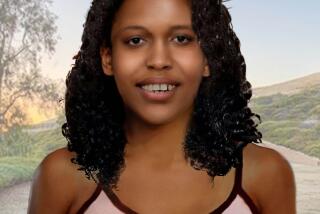Cal State Professor Cast as Anthropological Detective
- Share via
The skull fragment was described by investigators as about the size and shape of an ice cream bowl. It is the top portion extending down to the forehead, obviously a child’s.
Is it the remains of Laura Bradbury?
As others have many times before in Southern California, investigators asked Judy Suchey to find a clue.
Suchey, a professor of anthropology at Cal State Fullerton, is one of the nation’s handful of experts in the arcane field of deducing a person’s age, race, sex and other attributes from skeletal remains.
“For years I’ve known of her work,” said George Gill, a professor at the University of Wyoming who serves as secretary of the physical anthropology section of the American Academy of Forensic Sciences (AAFS). “She’s certainly one of the most active and most respected in our field,” Gill said.
Stanley Rhine, chairman of the AAFS anthropology section and a professor at the University of New Mexico, said Suchey has done much original research in how to measure aging in human bones. “She’s produced a very large body of data of extremely great importance in the field,” Rhine said.
But both Gill and Rhine said in separate interviews Tuesday that Suchey may have her hands full in this particular investigation. Judging from reports of how few and what kind of bones have been found, “the possibility of getting a lot of precise, exact information is pretty low,” Rhine said.
A spokeswoman for Suchey at Cal State Fullerton said Suchey would not publicly comment on her investigation.
But investigators said Tuesday that her preliminary report states that the skull was from a child between 2 and 5 years old who has been dead not more than 2 years. She estimated that the skull had been exposed to sunlight for between three and four months, investigators said.
It will probably require more bones to deduce much more than that, experts said. Even under good circumstances, a skeleton seldom provides a positive identification. “We can try to assist in identification, but we very seldom can do it ourselves,” Gill said.
Discovering even the most basic information “is going to be difficult, but occasionally you get lucky,” Rhine said.
“With luck, she could get some indication of age, but probably not much more,” Gill said. “I’m afraid she may be in trouble on sex and race.”
Gill said that if any “long bones,” such as upper arm or leg bones, are found, “you can get a pretty good idea of age. There are quite good studies on that. They correlate with age very nicely until 5 1/2 (years old).”
Teeth, too, are excellent age indicators, he said.
But determination of sex in the remains of young children is very difficult, even when more bones are available, he added.
Often these determinations turn on having just the right bone fragment to study, Gill said.
“Let’s say we wanted to get an idea if the person was of Asian extraction. We’d want to look at the mid-face slope in the area of the eye orbit.
“And the upper central incisor teeth are very useful. If it had a little curve on the edge--we call them shovel shapes--that’s indicative of American Indians and Asians. Some little tiny thing like that can help a lot,” Gill said.
Race determination is more difficult with the young, and especially if they are Caucasian, as is Laura Bradbury’s family.
In Caucasians, the most distinctive characteristic is “the mid-face, which takes on extreme prominence,” Gill said. “There are areas right between the eyes, including the bridge of the nose, and some other aspects of the mid-face that allow us to get over 90% accuracy--in adults.”
But often there is no trace of these characteristics yet developed in the young, he said.
“It would be so dependent on the small fragments. It depends on which fragments. Just a very few cranial fragments can give you all the things you want to find out, but without them you might not be able to tell age, race or anything.”
Gill said that there is an element of “art” in forensic anthropology. “Certainly people who’ve had a vast amount of experience are perceiving things that are not quantified all that well. But it’s a science. You can make measurements, and the confidence limits are defined.”
‘Able to Do Fine Job’
He said that in the areas requiring experience, Suchey “will be able to do a fine job.”
According to the Cal State Fullerton public information office, Suchey received her bachelor’s and master’s degree from the University of Kansas and her doctorate from UC Riverside.
She has taught anthropology at the University of Kansas, at the State University of New York at Potsdam and, beginning in 1969, at Cal State Fullerton.
Suchey has conducted numerous investigations for police agencies in Southern California counties.
“We use her several times a year on skeletal remains we find,” said Jim Beisner, chief deputy coroner in Orange County. “It (forensic anthropology) is very scientific, a very valuable part of the forensic team. We attach a great deal of credibility to it.”
More to Read
Sign up for Essential California
The most important California stories and recommendations in your inbox every morning.
You may occasionally receive promotional content from the Los Angeles Times.










